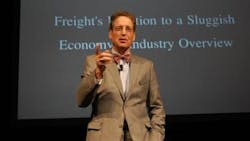2017 outlook: Some upside with Trump, but driver wage inflation a concern
This year has “felt bad” for trucking not so much because of a sluggish economy, but because many in the industry had high hopes that haven’t been met, according to transportation economist Noël Perry.
“When [2016] turned out to be relatively weak, particularly price-wise, people assumed that the trucking business was in recession,” Perry said. “The facts show it was not. However, it was well below expectations. Now as we enter 2017, expectations are low, and the economy is likely to be better than expectations—at least for the first half [of the year]. So the industry will feel better, even though things will be about the same.”
Perry joined macro economist Bill Witte on Thursday for the monthly FTR State of Freight webinar series. The focus was “2017 Risks,” and the discussion revolved around what can be expected from a Trump administration in terms of economic policy and the regulatory agenda.
In explaining the broader economic outlook, Witte likewise forecasts 2017 will be “a lot like” 2015 and 2016. His baseline estimates put GPD growth at 2.2% (up from 1.8% this year, and “better balanced” across the economy), but inflation will rise a tad, employment growth will continue to slow, but unemployment will still tick down, from 4.9% to 4.8%. Auto sales and housing starts will be about the same, while oil prices will rise from about $42 this year to $46.
The election, however, throws some uncertainty into the works.
“I think the impact of the election is, overall, positive,” Witte said. “Prior to the election, I didn’t see much upside, economically. The political situation raises the possibility that we could have some positive developments.”
Specifically, Witte’s “risk matrix” shows a “significant” chance (greater than 50%) for a positive impact on infrastructure spending, and “moderate” chance (25%-50%) for tax reform, with bipartisan support behind the former, while the Senate could well be a roadblock to the latter. He notes, however, that the actual impact on the economy will not be felt until well after 2017—although the anticipation of growth could provide a psychological boost as early as next year.
On the downside, Witte assigns “small” risk (25% or less) to political uncertainties, protectionist policies, and financial difficulties such as crisis in the “overvalued” equities markets.
“It’s easy to see deadlock,” Witte said. “We have a president-elect who is an unknown factor. It might be a different kind of deadlock, within the Republican party.”
Internationally, Witte doesn’t anticipate major changes, either positive or negative, although risks do remain, particularly with regard to China. The dollar should remain stable.
With regard to trucking, the U.S. employment situation is an indicator to keep an eye on. While employment is slowing, wages are accelerating as the economy approaches full employment, Witte adds.
“If you’re out there looking for workers, it’s going to be a tougher task than it was two or three years ago,” he said.
Perry is more direct.
“We have a more than 60% chance of having a shortage of equipment and drivers by the end of [2017]. This couldn’t come at a worse time for recruiting,” he said. “There is a significant chance that we could get wage inflation on the trucking side, particularly in the long-haul, over-the-road segments.”
On the other hand, a capacity shortage will lead to rate increases.
“The 2017 rate increases are going to exceed expectations,” Perry said. “I fully expect 2018 to be a difficult year for pricing if you’re a shipper.”
Unlike the delayed results of economic policies, the Trump White House could have an immediate impact on federal regulations, including rolling back Obama administration initiatives, Witte suggests. He anticipates pipeline construction will be among the first transportation sector programs.
“I think the regulatory environment has been a significant drag on the economy for the last seven or eight years,” Witte said. “You can argue about the social benefits, but a more permissive regulatory environment will have economic positives.”
Again, Perry gets to trucking specifics. While he doesn’t expect the Trump administration to reverse safety regulations, it could be “more realistic” in the way regulations are implemented.
Because FMCSA still has not published some of the technical standards for electronic logging devices, for instance, the Trump administration would be much more likely to call for a delay of the December 2017 implementation date, Perry explains. As a result, he will begin to “slow down” the regulatory impact he incorporates into the FTR forecasts.
Both Witte and Perry gave little credence to Trump’s campaign promise to deliver 4%-5% GDP growth.
“If Trump is going to get anything like what he has been touting, he’s going to need a massive increase in productivity. I think some increase in productivity is possible, but what would be required to achieve the kind of growth he’s talking about is out of the realm of possibility,” Witte said. “If he can get growth up from the 2% we’ve had during the recovery to the 3% level, that would be a significant positive achievement.”
Perry, however, simply used a “West Philadelphia” expletive to convey skepticism about Trump’s promise for economic improvement—then he added, “in the interest of balanced politics, nothing Hillary said was any more credible.”
About the Author
Kevin Jones 1
Editor
Kevin has served as editor-in-chief of Trailer/Body Builders magazine since 2017—just the third editor in the magazine’s 60 years. He is also editorial director for Endeavor Business Media’s Commercial Vehicle group, which includes FleetOwner, Bulk Transporter, Refrigerated Transporter, American Trucker, and Fleet Maintenance magazines and websites.


